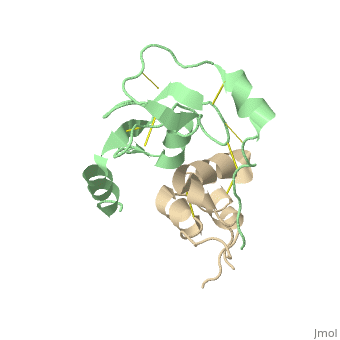Insulin-like growth factor binding protein: Difference between revisions
Jump to navigation
Jump to search
Michal Harel (talk | contribs) No edit summary |
Michal Harel (talk | contribs) No edit summary |
||
| Line 1: | Line 1: | ||
<StructureSection load='2dsp' size='340' side='right' caption=' | <StructureSection load='2dsp' size='340' side='right' caption='Insulin-like growth factor binding protein N terminal (green) complex with Insulin-like growth factor I (wheat) (PDB code [[2dsp]])' scene=''> | ||
== Function == | == Function == | ||
Insulin-like growth factor binding protein (IGFBP) are 7 homologous proteins which bind insulin-like growth factor I (IGF I)<ref>PMID:10605625</ref>. The N-terminal of IGFBP is the domain which binds IGF I. | Insulin-like growth factor binding protein (IGFBP) are 7 homologous proteins which bind insulin-like growth factor I (IGF I)<ref>PMID:10605625</ref>. The N-terminal of IGFBP is the domain which binds IGF I. | ||
== Disease == | == Disease == | ||
*IGFBP-3 and IGFBP-6 show inhibition of angiogenesis and promotion of cancer cell migration<ref>PMID:23126425</ref>,<ref>PMID:9815544</ref. <br /> | *IGFBP-3 and IGFBP-6 show inhibition of angiogenesis and promotion of cancer cell migration<ref>PMID:23126425</ref>,<ref>PMID:9815544</ref>. <br /> | ||
*IGFBP-3 level is decreased in patients with inflammatory bowel disease<ref>PMID:15844718</ref>.<br /> | *IGFBP-3 level is decreased in patients with inflammatory bowel disease<ref>PMID:15844718</ref>.<br /> | ||
*IGFBP-4 overexpression inhibits the growth of colon and prostate cancer cells<ref>PMID:16685432</ref>.<br /> | *IGFBP-4 overexpression inhibits the growth of colon and prostate cancer cells<ref>PMID:16685432</ref>.<br /> | ||
Revision as of 11:01, 29 March 2016
FunctionInsulin-like growth factor binding protein (IGFBP) are 7 homologous proteins which bind insulin-like growth factor I (IGF I)[1]. The N-terminal of IGFBP is the domain which binds IGF I. Disease
RelevanceStructural highlights |
| ||||||||||
3D structures of insulin-like growth factor binding protein3D structures of insulin-like growth factor binding protein
Updated on 29-March-2016
ReferencesReferences
- ↑ Hwa V, Oh Y, Rosenfeld RG. The insulin-like growth factor-binding protein (IGFBP) superfamily. Endocr Rev. 1999 Dec;20(6):761-87. PMID:10605625 doi:http://dx.doi.org/10.1210/edrv.20.6.0382
- ↑ Bach LA, Fu P, Yang Z. Insulin-like growth factor-binding protein-6 and cancer. Clin Sci (Lond). 2013 Feb;124(4):215-29. doi: 10.1042/CS20120343. PMID:23126425 doi:http://dx.doi.org/10.1042/CS20120343
- ↑ Rocha RL, Hilsenbeck SG, Jackson JG, VanDenBerg CL, Weng Cn, Lee AV, Yee D. Insulin-like growth factor binding protein-3 and insulin receptor substrate-1 in breast cancer: correlation with clinical parameters and disease-free survival. Clin Cancer Res. 1997 Jan;3(1):103-9. PMID:9815544
- ↑ Kirman I, Whelan RL, Jain S, Nielsen SE, Seidelin JB, Nielsen OH. Insulin-like growth factor binding protein 3 in inflammatory bowel disease. Dig Dis Sci. 2005 Apr;50(4):780-4. PMID:15844718
- ↑ Durai R, Davies M, Yang W, Yang SY, Seifalian A, Goldspink G, Winslet M. Biology of insulin-like growth factor binding protein-4 and its role in cancer (review). Int J Oncol. 2006 Jun;28(6):1317-25. PMID:16685432
- ↑ Heald AH, Cruickshank JK, Riste LK, Cade JE, Anderson S, Greenhalgh A, Sampayo J, Taylor W, Fraser W, White A, Gibson JM. Close relation of fasting insulin-like growth factor binding protein-1 (IGFBP-1) with glucose tolerance and cardiovascular risk in two populations. Diabetologia. 2001 Mar;44(3):333-9. PMID:11317665 doi:http://dx.doi.org/10.1007/s001250051623
